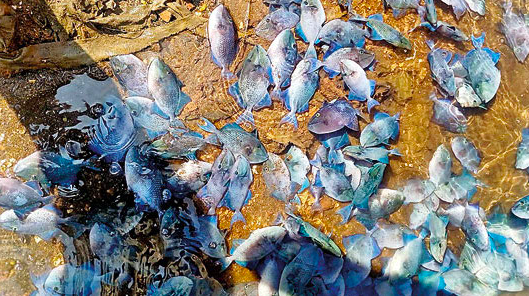Trincomalee, fish dying from excessive algae concentration
The phenomenon, already recorded elsewhere, happened for the first time in the port city where the Mahaweli River flows. The affected species is odonus niger, found decomposing in shallow bays. Dr Sujeewa Athukoorala: ‘Oxygen deficiency and gill obstruction’. Scientists: algae proliferation favoured by ‘sunlight, warm water, carbon dioxide and fertilisers’.
Trincomalee (AsiaNews) - A nauseating smell has invaded Trincomalee, a port city and tourist resort, centre of Tamil-speaking culture, located on the north-eastern coast of Sri Lanka. It was caused by the presence of thousands of rotting fish that washed ashore and floated in shallow bays.
It happened between 29 October and 1 November, coinciding with Halloween week, sparking rumours of unlikely supernatural occurrences among tourists and residents. The species affected was mainly the red-tooth triggerfish (odonus niger), so called because of its characteristic red teeth visible when its mouth is closed.
According to Dr Sujeewa Athukoorala, a scientist at the National Aquatic Resources Research and Development Agency (NARA) in Colombo, ‘satellite images from the affected period indicate a high-density algal bloom in the waters of Trincomalee’.
The phenomenon, which can be recognised by the change in the colour of the water, ‘probably caused a shortage of oxygen in the fish's habitat, as dense algae can clog the gills of triggerfish, impairing their respiration. Thus, the combination of low oxygen and gill obstruction may have led to the mass death of the triggerfish'.
Scientists Nishantha Adikari and Anuradha Dissanayake informed AsiaNews that ‘Sri Lanka experienced heavy rains throughout October and the Mahaweli River (the country's longest river, ed.), which flows into the sea at Trincomalee, would have carried large volumes of fresh water and nutrients into the marine environment.
During torrential rains, excess nutrients are carried into the sea and could trigger algal blooms. ‘Studies have revealed that there are four major causes of algal blooms: sunlight, warm water, carbon dioxide and fertilisers. When these four factors are at the right levels, the algae have the ability to double their mass every six hours'.
Once the amount of nutrients is high, a harmful level of algae growth is reached and, at this point, the fish in the water cannot find their usual food and the bottom plants begin to die due to the lack of sunlight that causes thick floating carpets of decaying algae to form on the surface, further damaging the ecosystem.
At this point, the water becomes depleted of oxygen and becomes a ‘dead zone’ that kills fish and most other organisms. ‘As the algae decompose, phosphorous is released into the water and flows downstream where it can trigger other algae blooms. Eventually, the phosphorus reaches the coastal wetlands. About 90 per cent of ocean life depends on a coastal wetland,' Nishantha and Anuradha explain.
According to environmentalists Joseph Aruliah and Stephen Ravichandrarajah, residents of Trincomalee, ‘a similar situation has occurred in the Maldives: several cases of dead fish stranding in large numbers on the shores of the northern atolls in September 2023’. But this is the first time such an incident has occurred in Trincomalee and therefore ‘it is necessary for NARA to conduct a long-term research study to ascertain the cause’.
‘Occasionally, cases of fish deaths are also observed in India. In most cases, this occurs due to complications from high temperatures.’ In most of these cases, a combination of natural and non-natural causes triggered a recent increase in fish deaths, and more often than not, the fish were in a state of pure physical exhaustion, which eventually led to their death.
‘Recent research indicates that the increase in fish deaths is the result of several factors, including the reduction in water purity and quality. Studies have also listed India, China, Kenya and the United States as countries that have experienced a surge in fish mortality,’ they conclude.







.png)










